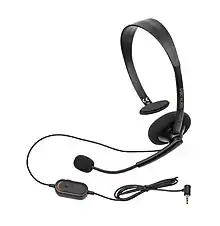Voice chat in online gaming
Voice chat is telecommunication via voice over IP technologies—especially when those technologies are used among players in multiplayer online games.

Users might use either a VoIP engine system that is built into the game, or a separate program.
Video game consoles
In 2000, SegaNet released the first voice-chat-compatible browser for the Dreamcast. YahooChat! and other such internet services worked on the Java-compatible web browsers with the ability of voice chat with the microphone, although it was available in its HTML servers. This browser web integration became a standard in future game consoles.
Long-distance telephone programs such as Dream call were integrated within the browser. Other games such as Seaman and Alien Front Online included voice chat via the microphone. In 2001, Sony released the Network adapter for their PlayStation 2 video game console, which allowed voice chatting with a headset. In 2002, Microsoft launched the Xbox Live service, which supports voice chatting. Later, Microsoft required Xbox Live console game developers to integrate voice chat into their games and bundled a microphone and headset with the Xbox Live retail unit. In 2005, Nintendo launched the Nintendo Wi-Fi Connection, an online multiplayer service for both the Nintendo DS and for the Wii. Metroid Prime Hunters, which launched in March 2006, was the first game that allowed voice chatting through the Nintendo DS’s microphone. [citation needed] Nintendo also released a Nintendo DS headset for voice chat alongside the release of Pokémon Diamond and Pearl (2006).
While voice chat has become a big hit in console games, it also created problems such as griefing or the persistent harassment of other players online. Voice capability presents the greatest risk of traditional cyberbullying and harassment. For instance, being used to send sexist and misogynistic communications towards female players. A specific example was a publicized audio recording of EVE Online players perpetrating the so-called “Bonus Round” scam over voice chat. Portions of the audio contained graphic language.
See also
References
Categorye:Online video game services